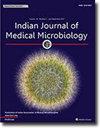Risk factors and clinical outcomes in patients with colistin-resistant Klebsiella pneumoniae bloodstream infection: A retrospective analysis
IF 1.4
4区 医学
Q4 IMMUNOLOGY
引用次数: 0
Abstract
Purpose
Increase in the incidence of colistin-resistant K. pneumoniae (ColR) necessitates the study of risk factors responsible for its emergence. The current study aims to investigate the risk factors and clinical outcomes in ColR patients.
Material and methods
A retrospective study was conducted at a tertiary care hospital in India over 18 months (March 2021 to August 2022). We included patients >18 years (41 male, 38 female), with ColR and colistin-intermediate (ColI) strains. These patients were assessed for demographics, underlying diseases, antimicrobial treatment, clinical scores (APACHE II, SOFA), and outcome.
Results
The presence of a central venous catheter (CVC) was a significantly associated risk factor for ColR infections (p = 0.011). Additionally, prior antibiotic exposure within 3 months (p = 0.049) and CVC presence (p = 0.034) were associated with non-survival among ColR patients. Higher APACHE II and SOFA scores were associated with mortality among ColI patients. The presence of CCI >3 (p = 0.040) and previous history of ICU stay (p = 0.032) emerged as significant factors associated with the isolation of ColR K. pneumoniae among patients with previous history of colistin/polymyxin intake.
Conclusion
The study highlights the risk factors associated with ColR K. pneumoniae. These findings underscore the need for prudent antimicrobial stewardship.
耐粘菌素肺炎克雷伯菌血流感染患者的危险因素和临床结果:回顾性分析
目的随着耐粘菌素肺炎克雷伯菌(ColR)发病率的增加,有必要对其发生的危险因素进行研究。本研究旨在探讨ColR患者的危险因素和临床结果。材料和方法在印度一家三级保健医院进行了为期18个月(2021年3月至2022年8月)的回顾性研究。我们纳入了18岁的患者(41男,38女),感染ColR和粘菌素中间(ColI)菌株。对这些患者进行人口统计学、基础疾病、抗菌药物治疗、临床评分(APACHE II、SOFA)和结果的评估。结果中心静脉导管(CVC)的存在是ColR感染的显著相关危险因素(p = 0.011)。此外,3个月内的抗生素暴露(p = 0.049)和CVC存在(p = 0.034)与ColR患者的非生存相关。较高的APACHE II和SOFA评分与大肠杆菌患者的死亡率相关。CCI >;3的存在(p = 0.040)和既往ICU住院史(p = 0.032)是既往摄入粘菌素/多粘菌素的患者分离肺炎克雷伯菌的重要因素。结论本研究突出了与肺炎克雷伯菌相关的危险因素。这些发现强调了谨慎管理抗菌药物的必要性。
本文章由计算机程序翻译,如有差异,请以英文原文为准。
求助全文
约1分钟内获得全文
求助全文
来源期刊

Indian Journal of Medical Microbiology
IMMUNOLOGY-
CiteScore
2.20
自引率
0.00%
发文量
154
审稿时长
73 days
期刊介绍:
Manuscripts of high standard in the form of original research, multicentric studies, meta analysis, are accepted. Current reports can be submitted as brief communications. Case reports must include review of current literature, clinical details, outcome and follow up. Letters to the editor must be a comment on or pertain to a manuscript already published in the IJMM or in relation to preliminary communication of a larger study.
Review articles, Special Articles or Guest Editorials are accepted on invitation.
 求助内容:
求助内容: 应助结果提醒方式:
应助结果提醒方式:


